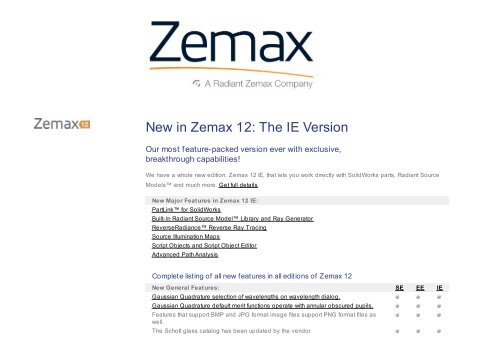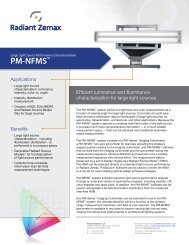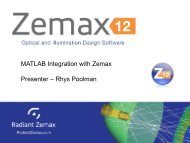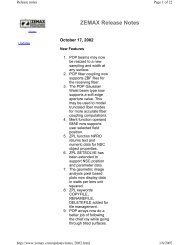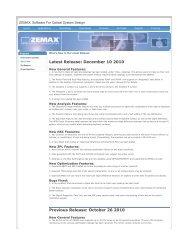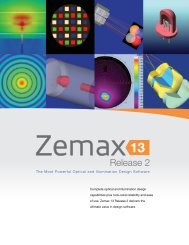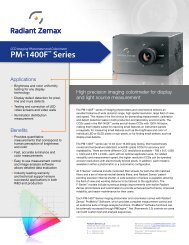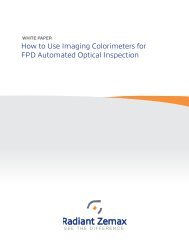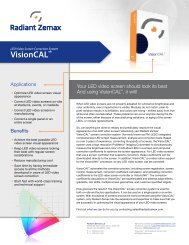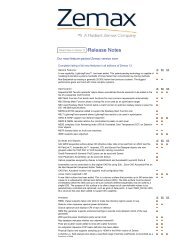2012 - Zemax
2012 - Zemax
2012 - Zemax
You also want an ePaper? Increase the reach of your titles
YUMPU automatically turns print PDFs into web optimized ePapers that Google loves.
New in <strong>Zemax</strong> 12: The IE Version<br />
Our most feature-packed version ever with exclusive,<br />
breakthrough capabilities!<br />
We have a whole new edition, <strong>Zemax</strong> 12 IE, that lets you work directly with SolidWorks parts, Radiant Source<br />
Models and much more. Get full details.<br />
New Major Feat ures in <strong>Zemax</strong> 12 IE:<br />
PartLink for SolidWorks<br />
Built- In Radiant Source Model Library and Ray Generator<br />
ReverseRadiance Reverse Ray Tracing<br />
Source Illumination Maps<br />
Script Objects and Script Object Editor<br />
Advanced Path Analysis<br />
Complete listing of all new features in all editions of <strong>Zemax</strong> 12<br />
New General Feat ures: SE EE IE<br />
Gaussian Quadrature selection of wavelengths on wavelength dialog.<br />
Gaussian Quadrature default merit functions operate with annular obscured pupils.<br />
Features that support BMP and JPG format image files support PNG format files as<br />
well.<br />
The Schott glass catalog has been updated by the vendor
The CVI Melles Griot lens catalog has been updated by the vendor<br />
The Hoya glass catalog has been updated by the vendor<br />
The Optimax test plate list has been updated by the vendor<br />
A Source Illumination Map feature projects one or more RSMX/IESNA/Eulumdat<br />
sources onto a distant plane and displays a true color image of the illumination<br />
pattern formed<br />
New RSMX/IESNA/Eulumdat RSM viewers<br />
RSMX/IESNA/Eulumdat Directivity plots<br />
Spectrum Plots display the relative intensity vs. wavelength for a defined spectral<br />
distribution.<br />
Radiant Source Model viewer lets you see the actual source image from any angle<br />
in full color<br />
CIE 1931/1976 Color Chart feature<br />
New Sequent ial Surf ace Types: SE EE IE<br />
New binary optic 4 surface added to provide up to 20 different radial zones, each of<br />
which supports the capability of the Binary Optic 2 surface.<br />
Q- type (Forbes) aspherics now support conic terms.<br />
A new sequential Slide Surface has been added. This surface imports a PNG, BMP<br />
or JPG file and uses the variable transmission to attenuate the beam. The feature<br />
can be used to model reticles or arbitrary apodization filter.<br />
New Analysis Feat ures: SE EE IE<br />
The Geometric Encircled Energy feature is multithreaded for faster computation<br />
speed.<br />
The Sag Table feature reports additional data on the maximum slope deviation, and<br />
RMS slope and sag deviations as well. This data is important for the<br />
manufacturability of aspheric surfaces.<br />
The Image Simulation feature supports a "Use Relative Illumination" checkbox which<br />
optionally disables the consideration of RI. Previously, RI was always considered.<br />
The polarization pupil map text listing now lists the orientation angle of the<br />
polarization ellipse.<br />
The diffraction encircled energy plot now supports user defined image deltas when<br />
using the FFT PSF.<br />
A glass Dispersion vs. Wavelength plot has been added.<br />
A Light Source Analysis feature is now under the Image Simulation group of features<br />
that created an image based upon tracing a list of rays in .DAT or .SDF files. This<br />
adds the capability to use Source File data with purely sequential optical systems.
A new CAD file Part Viewer has been added so that CAD objects may be viewed<br />
prior to loading.<br />
New NSC Feat ures: SE EE IE<br />
Diffraction grating objects now split rays by order for both reflected and transmitted<br />
light.<br />
Objects may now ignore rays 'upon launch', which is very helpful for eliminating<br />
geometry errors when rays originate close to a geometry object.<br />
New 'named filters' allows filters to be given meaningful names and stored.<br />
New ~ and $ path filters with # wild card added.<br />
Layout plots use path filters, and the spacebar can be used to change filters.<br />
Odd asphere lenses may now be converted from sequential to NSC mode using<br />
Tools. Convert to NSC.<br />
New PartLink for SolidWorks lets you load and modify SolidWorks part files from<br />
within the <strong>Zemax</strong> environment.<br />
Built- in Radiant Source Model library and Ray Generator<br />
ReverseRadiance traces rays from a screen back to the Radiant Source Model<br />
to compute screen intensity variance.<br />
A new "Advanced Path Analysis" feature groups rays from a ZRD file according to<br />
the path the rays took through the system. Rays that took the same path, in terms of<br />
the order in which different objects were interacted with, are summed so the total flux<br />
in each path can be determined. This feature also may automatically generate path<br />
filters so the groups of rays may be studied separately.<br />
A new 'script object' and associated Script Object Editor, has been added to allow<br />
parametric objects to be built from operations on primitive objects.<br />
New ZPL Feat ures: SE EE IE<br />
MODIFY SETTINGS now supports all options on the Relative Illumination feature.<br />
MODIFY SETTINGS now supports all options on the Polarization Pupil Map.<br />
New Ext ension Feat ures: SE EE IE<br />
MODIFY SETTINGS now supports all options on the Polarization Pupil Map.<br />
MODIFY SETTINGS now supports all options on the Relative Illumination feature.<br />
REMOVE VARIABLES removes all variables.<br />
Set NSC Solve and Get NSC Solve set and get solve and variable data on NSC<br />
editor values.<br />
New Opt imizat ion Feat ures: SE EE IE
Gaussian Quadrature default merit functions are now supported for obscured pupils.<br />
SDRV has been added to return first and second derivatives of the surface sag in the<br />
tangential and sagittal directions. This is very helpful in controlling aspheric surfaces<br />
during optimization<br />
BFSD has been expanded to support RMS sag deviation and slope deviation data.<br />
This is very helpful in controlling aspheric surfaces during optimization<br />
GENC and GENF now optionally suppresses scaling by the diffraction limit.<br />
CODA has been extended to report the major axis, mir axis, and angle of the<br />
polarization ellipse.<br />
UDOP now supports a user definable timeout setting, to allow complex calculations<br />
more time to complete.<br />
Bugs Fixed:<br />
The NSC Source Gaussian was not correctly accounting for initial phase if the Position parameter was nonzero.<br />
The NSC Source Ellipse was not generating the correct angular distribution when using the Gx and Gy<br />
factors, and the angles were large (Gx or Gy on the order of 2 or less).<br />
Decentered Zernike terms on the grid sag surface were t correctly used in compute the local surface<br />
normal. This bug could cause incorrect ray tracing results.<br />
The text listing of the surface sag plot was inverted top to bottom.<br />
A small change was made to the image sampling spacing in the Huygens PSF and MTF computations to<br />
improve accuracy.


